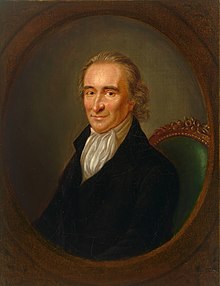Thomas Paine
Penampilan
Thomas Paine | |
|---|---|
 Portret lukisan Laurent Dabos (sekitar thn. 1792) | |
| Kelahiran | Thomas Pain 9 Februari 1737 |
| Meninggal dunia | Jun 8, 1809 (umur 72) Bandar Raya New York, Amerika Syarikat |
| Pasangan | Mary Lambert (k. 1759), Elizabeth Ollive (k. 1771) |
| Era | Zaman Kesedaran |
| Sekolah | Kesedaran, liberalisme, republikanisme |
Kepentingan utama | Politik, etika, agama |
| Tandatangan | |
Thomas Paine (lahir Thomas Pain;[1] 9 Februari 1737 (29 Januari 1736 menurut takwim Julius)[Note 1] – 8 Jun 1809) merupakan seorang aktivis, filsuf, pakar teori dan revolusioner Amerika Syarikat. Beliau merupakan antara Bapa Pengasas Amerika Syarikat yang masyhur melalui penulisan dua karya risalah paling berpengaruh sewaktu bermulanya Revolusi Amerika lalu mendorong golongan pemberontak Patriot mengisytiharkan kemerdekaan mereka dari Britain pada 1776.[2] Fahaman beliau mencerminkan retorik hak asasi manusia transnasional yang wujud semasa Zaman Pencerahan pada ketika itu.[3]
Biografi
[sunting | sunting sumber]Bibliografi
[sunting | sunting sumber]Nota
[sunting | sunting sumber]- ^ Conway, Moncure D. (1908). The Life of Thomas Paine. Volume 1. Cobbett, William, Illustrator. G. P. Putnam's Sons. m/s. 3. Dicapai pada October 2, 2013.
|volume=has extra text (bantuan) – In the contemporary record as noted by Conway, Paine's birth date is given as January 29, 1736–37. Common practice was to use a dash or a slash to separate the old-style year from the new-style year. In the old calendar, the new year began on March 25, not January 1. Paine's birth date, therefore, would have been before New Year, 1737. In the new style, his birth date advances by eleven days and his year increases by one to February 9, 1737. The O.S. link gives more detail if needed.
Rujukan
[sunting | sunting sumber]- ^ Ayer, Alfred Jules (1990). Thomas Paine. University of Chicago Press. m/s. 1. ISBN 0-226-03339-2.
- ^ Henretta, James A.; dll. (2011). America's History, Volume 1: To 1877. Macmillan. m/s. 165. ISBN 9780312387914.
- ^ Solinger, Jason D. (2010). "Thomas Paine's Continental Mind". Early American Literature. 45 (3): 593–617.

